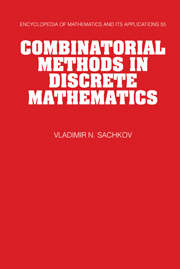6 - Pólya's theorem and its applications
Published online by Cambridge University Press: 22 March 2010
Summary
We have pointed out the important role of formalizing the notion of the indistinguishability of elements in enumerative combinatorial problems. A fundamental contribution to the development of the methods of such formalization was made by Pólya in his famous paper (Pólya, 1937). The ideas in this paper were developed by de Bruijn (Beckenbach, 1964) and other mathematicians. It should be noted that, prior to the paper (Pólya, 1937), a similar method had been suggested by Redfield in (Redfield, 1927).
The essence of the method of solving enumerative problems, referred to as Pólya's enumeration theory, can be described as follows. There is a set Y of elements such that each element possesses a characteristic or weight which takes values from a ring. The distribution of the elements of the set over the weights is determined by a generating function F, usually of several variables. The set of configurations of the form f : X → Y, where X is a linearly ordered set, is considered. A characteristic or weight is also assigned to each configuration of the set. A group A of permutations generates an equivalence relation on the set of all configurations which determines the notion of the distinguishability of configurations. The non-equivalent configurations with given characteristics or weights are enumerated by a generating function Φ. The main theorem of Pólya's enumeration theory gives an expression of the generating function F in terms of the generating function F using some polynomial Z of several variables called the cycle index.
- Type
- Chapter
- Information
- Combinatorial Methods in Discrete Mathematics , pp. 272 - 294Publisher: Cambridge University PressPrint publication year: 1996

